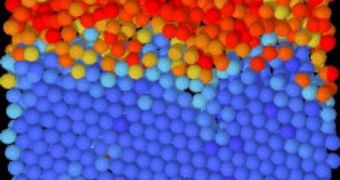Scientists at the Emory University have for the first time ever imaged the interactions that take place in the fuzzy layer between crystal and liquid molecules, and were able to determine that the contact area is indeed very, very small. Details of their achievements appear in this week's issue of the respected journal Proceedings of the National Academy of Sciences (PNAS).
“Imagine you're a water molecule in a glass of ice water, and you're floating right on the boundary of the ice and the water. So how do you know if you're a solid or a liquid? The theory that surface waves move along the crystal/liquid boundary – the intrinsic interface – dates back to 1965 and is well established. What we've done is found a way to take a picture of the intrinsic interface, measure it, and show how it fluctuates over time,” states Emory University physicist and associate professor of physics Eric Weeks.
“The transition from completely organized to completely disorganized goes very quickly, spatially,” the expert says of the boundary layer. To see the transition, and hear Weeks explaining the process, go here.
The physicist and his team are using small plastic balls, each the diameter of roughly a cell nucleus, to model various states of matter and the interactions between them. The way they do that is by accurately controlling the concentrations of the balls in their respective solutions. “Water molecules are too small to study while they are fluctuating. We used the plastic spheres to resize an experiment to a scale that we could observe. You lose some of the detail when you do this, but you hope it's not the critical detail,” he explains.
“You can watch as the boundary fluctuates. The yellow area along the bumpy line is liquid, but almost crystal. The light blue area is crystal, but almost liquid. The zone of confusion is less than two particles thick. By looking at the tiniest scale possible, we can see that the fuzzy region between the two areas is much smaller than we previously thought,” Weeks adds of the area of fluctuation between the two states of matter. The work was funded through the National Science Foundation (NSF) Faculty Early Career Development (CAREER) Program.

 14 DAY TRIAL //
14 DAY TRIAL //